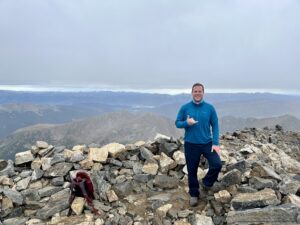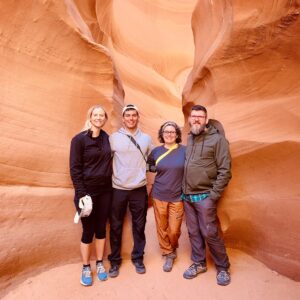“The serenity of a clear blue mountain lake…And the Colorado Rocky Mountain high. I’ve seen it rainin’ fire in the sky.” John Denver lived in Aspen, Colorado when he wrote “Rocky Mountain High,” so you already know how inspiring this scenery can be. You can’t look in any direction without seeing a stunning view. The city is known for being a ski lover’s dream, but that doesn’t mean you need snow to enjoy your travels. In the summer, there are horseback rides, events, a scenic gondola, and even the Lost Forest in the nearby town of Snowmass which has ziplines, an alpine coaster, and more. But what if you’re visiting in one of the off-seasons — post-snow spring or pre-snow late autumn? Don’t worry, we still loved our time in Aspen and will help you do the same! Plus, you’ll definitely be avoiding the crowds.
Logistics for Aspen
The mountain town of Aspen, Colorado is an intersection of luxury and the outdoors. For the average traveler, they’ll find the prices of the hotels and restaurants to be as steep as the mountains themselves. Aspen has an airport, but any affordable flights will likely be through Denver about 3.5 hours away. As budget travelers, we opted to do Aspen as a day trip, staying instead in the Silverthorn area. You can check out our accommodations in our Breckenridge blog, another great Colorado day trip destination! Your best bet is to find parking in Aspen (we used Rio Grande Parking as it had a $12 day max limit) and then use the city buses. Aspen is quite walkable and the city buses are completely free. Use the public transit feature on the Google Maps app to see routes and times or their website HERE. Staying outside of Aspen allowed us to add Independence Pass to our Aspen day, making it extra special. Let’s start there…
Independence Pass Road



The journey to Aspen is an adventure in itself. The infamous Independence Pass Road is known for being equal parts darling and daunting. Large strips of this journey are simple and scenic. Others…not so much. While there are stunning vistas, a few parts of the journey are quite narrow and nerve-racking. The only part we felt uncomfortable with was the switchback section where you climb into the mountains (coming from the East). With a cliff on one side, it was shocking not to have guardrails or much of a shoulder. We took it pretty slow. Rest assured that Independence Pass Road is paved, so we were able to cross it in a Prius.
It’s worth doing Independence Pass Road once on your trip to Aspen, but you’ll want to allot a lot of time for it. Coming from Silverthorne, it took us about four hours even though Google Maps estimated it just over two. We did make some stops along the way, which we’ll get to in our next section! Also, I wouldn’t recommend driving this after dark. If that’s the case, take the other end of 82 through Carbondale. Independence Pass Road closes from late October to May, but you’ll want to check to make sure an early or late snow hasn’t restricted the route.
Twin Lakes


You’ll want to fuel up before you begin your journey as there are no stations along the Pass. Coming from the northeast, Leadville is your last solid spot for gas. Leadville is the highest-elevation city in the United States and has a rich Wild West history. Continuing on, the first stop we’d recommend is Twin Lakes. Twin Lakes is a quick vista point with a parking lot for campers and fisherpeople. If you plan on taking a full day to explore Independence Pass Road (as some travelers do), consider the easy 4.6-mile Interlaken Trail to the historic Interlaken Hotel. Otherwise, simply admire the view and keep your eyes out for wildlife. Though we didn’t get the chance to try it ourselves, the nearby Roadhouse Coffee + Ice Cream appears quite cozy!
Continental Divide Overlook


After you’ve conquered the aforementioned switchbacks, release the breath you’ve been holding at the Continental Divide Overlook. In layman’s terms, the US’s Continental Divide is significant because water on one side of it leads to the Atlantic whereas water on the other side of it leads to the Pacific. This overlook won’t give you a view of any water, but you will have stunning mountain views. Stretch your legs and walk the short path to the placard that points out the location of various peaks. Fair warning, the vault toilets here might be scarier than the drive itself. If your legs have a bit more juice, just down the road is Linkins Lake. We skipped this stop, but Google Reviews consider the trail to be short, steep, and rewarding.
Independence Ghost Town



The parking lot for Independence Ghost Town is so discreet that we almost missed it. Most of the buildings are at the bottom of a small slope, but if you’re driving and see the structure of the Independence Pass Abandoned Mine, you’ve gone too far. You’ll want about 30 minutes to walk the dirt path between the still-remaining structures. You can’t enter the buildings but informational placards tell the previous function of each cabin. Between 1879 and 1882, Independence had a short-lived gold rush. By the winter of 1899, any remaining residents fled to Aspen via skis. The area is well-maintained and gives travelers a taste of the impact mining had on the region.
Grottos Day Use Area


You’re probably ready to get to Aspen by now, but our final recommended stop is Grottos Day Use Area. Instead of Grandma’s house, these short trails take you over the river and through the woods to caves. According to some reviews, getting in and out of the cave can be challenging. As we were in a rush and not looking to twist an ankle, we opted out of any spelunking. Nevertheless, the forest was serene and worth the short stop.
Maroon Bells


Congratulations on finally making it to Aspen! Now it’s time to jump on a bus for some more driving. I wish I was joking, but I promise it’s worth it. The Maroon Bells are the most popular attraction in Aspen and shuttle bus tickets can fill up no matter the season. Buy your timed-entry tickets in advance for the shuttle from Aspen Highlands. Then you can take any bus back that has space, and they come about every 20 minutes. The only cars allowed to drive to the Maroon Bells are the full-day hikers that arrive before 8 am and leave after 5 pm. Parking at Aspen Highlands can be very expensive, so we took the free city bus from downtown. They want you to arrive at the ticket office for check-in at least 15 minutes early, so plan accordingly.
The shuttle ride from the Highlands was pleasant. The audio recording they played was very informative about the geological and anthropological history of the area. From the drop-off point (where there are bathrooms) there are plenty of hiking options. The two most popular are the Crater Lake Trail and the Maroon Bells Scenic Loop Trail. We completed the Crater Lake Trail which took about two hours. This 3.5-mile out-and-back trail gains close to 700 ft of elevation. At such a high altitude, I for one was huffing and puffing. You’ll wind through a forest of Aspen trees, get stunning mountain views, and traverse rocky terrain. Crater Lake itself we found to be disappointing and drier than expected. The view from Maroon Lake that you first pass on either trail was much better. If you have mobility issues, the Maroon Bells Scenic Loop trail is 1.9 miles and considered easy. Plus, you’ll still get to see a lake, mountains, and Aspens. We felt good about the workout we got getting to Crater Lake, so both trails have their perks!
Felix Coffee




On a previous autumn visit to New York City, I visited Felix Coffee’s flagship. Thinking all of their locations were in the Big Apple, I was excited to discover an Aspen outpost. The interior is intentional, elegant, and refined, yet the plush velvet seating still makes it cozy. If, like me, you’re a fan of super sugary complex flavor lattes, you’re not going to find that here. The drink selection is pretty basic, but they do simplicity well. Aspen’s Felix Coffee location is attached to Hotel Jerome. This historic hotel has been around since 1889 and nightly prices start at about $700. Drop a zero and we’d be there! Nevertheless, we exited Felix Coffee through the hotel lobby which gave us the perfect chance to see what it is all about. There are other dining and drink options at the hotel if you want another way of visiting.
Downtown Aspen



Downtown Aspen is full of fancy restaurants, unique shops, and notable architecture. Most places are going to cost a pretty penny, but there are a couple traditional souvenir shops. Still, it’s fun to window shop especially on the pedestrian street of E Hyman Ave. This is also where you can find the Aspen Art Museum which is free to visit. Unfortunately, we didn’t have much time to walk around the town. If you do, consider a walking tour or ghost tour to hear a bit more about Aspen’s history.
John Denver Sanctuary



Our final Aspen recommendation is a tribute to John Denver in the heart of the city. The John Denver Sanctuary Park is a small city park of winding trails that go through gardens and along a stream. The highlight here is the shrine where his lyrics are carved into stone. It’s quite meditative to quietly read through them as you listen to the river. You can see the entirety of the park within twenty minutes or relax there for an hour or two. They also hold an annual event each October to pay homage to the icon.
Other Top Posts!

24-Hour Off-Season Itinerary for Vail, Colorado
Vail may be known for it’s slopes, but there is still plenty to do in the town’s budget-friendly off-season!

Ultimate 3 Day Zion National Park Itinerary
Zion National Park is a stunning and diverse landscape located in southwestern Utah. Read and discover how best to plan your ultimate 3 day itinerary in this magnificent place!

A 24-Hour Autumn Escape to Cooperstown, NY
From a fall foliage train to a family-friendly brewery, this Cooperstown itinerary will give you all of the autumn feels!

Exploring Denver and the Surrounding Areas
Hitch along with my college friend and local Coloradan as we explore Denver and the surrounding area with quick stops and day trips alike!

24-Hour Off-Season Itinerary for Breckenridge, Colorado
From a ski lodge-themed cafe and mining exhibits, to a giant troll in the woods and alpine lakes, there’s a lot to do in Breckenridge all year!

Epic Day Trip From Zion to Antelope Canyon
Looking to plan your day trip from Zion to Antelope Canyon? Join us on an epic adventure from Zion to Antelope with some epic stops in between!
